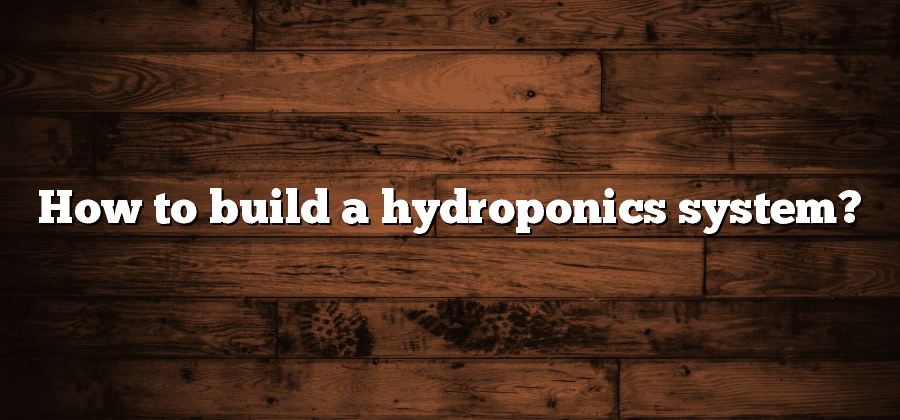Understanding Hydroponics Basics
Hydroponics is a method of growing plants without using soil. Instead, plants are grown in a nutrient-rich water solution, allowing them to receive all the necessary minerals and vitamins they need for optimal growth. This revolutionary technique has gained popularity in recent years due to its numerous advantages.
One of the main benefits of hydroponics is its ability to save water. Since plants are grown in a controlled environment, the water used in hydroponic systems can be recirculated, significantly reducing the amount of water waste compared to traditional farming methods. Additionally, hydroponics allows for precise control over the nutrient levels and pH of the water, ensuring that the plants receive the optimal balance of nutrients needed for healthy growth. This eliminates the need for excessive fertilizers and pesticides, making hydroponics a more environmentally friendly and sustainable option for agriculture.
Selecting the Right Hydroponic Setup
When it comes to selecting the right hydroponic setup, there are several factors to consider. First and foremost, you need to assess the space you have available. Hydroponic systems can vary in size and complexity, so it’s important to choose one that will fit within your designated area. Consider the dimensions of the space, as well as any potential limitations or restrictions.
Next, think about your level of experience and expertise in hydroponics. If you’re new to this method of gardening, it’s advisable to start with a simpler setup that is easier to manage. This will allow you to learn the basics and gain confidence before venturing into more advanced hydroponic systems.
Furthermore, take into account the types of plants you plan on growing. Different plants have different requirements in terms of lighting, nutrient delivery, and oxygenation. Make sure the system you choose can accommodate the specific needs of the plants you wish to cultivate.
Lastly, consider your budget. Hydroponic setups can vary greatly in price, so it’s important to set a realistic budget and stick to it. Keep in mind that while some systems may be more expensive initially, they may also provide better long-term performance and yield.
By carefully considering these factors, you can make an informed decision when selecting the right hydroponic setup for your needs.
Choosing the Ideal Growing Medium
When it comes to hydroponic gardening, one of the key factors that determines the success of your plants is the choice of the growing medium. Unlike traditional soil-based gardening, hydroponics relies on a medium that provides support for the plants while also allowing for the efficient delivery of water, oxygen, and nutrients directly to their roots. Therefore, it is crucial to select a growing medium that meets these requirements and promotes healthy plant growth.
There are several options available when it comes to choosing the ideal growing medium for your hydroponics system. Some commonly used mediums include perlite, vermiculite, coconut coir, and rockwool. Each medium has its own set of characteristics and advantages, so it is important to consider factors such as water retention, aeration, and pH stability when making your decision. Additionally, it is essential to ensure that the chosen medium is clean and free from any contaminants that could negatively impact plant health. By carefully selecting the right growing medium for your hydroponic setup, you can provide your plants with the ideal environment to thrive and produce high-quality yields.
Selecting the Appropriate Nutrient Solution
When it comes to hydroponic gardening, selecting the appropriate nutrient solution is a critical aspect of achieving successful plant growth. Nutrient solutions play a crucial role in providing all the necessary elements for plants to thrive in a soilless environment.
To begin with, it is important to understand that there are various types of nutrient solutions available in the market. These solutions are designed to cater to different plant needs, growth stages, and crop varieties. Some nutrient solutions are specifically formulated for leafy greens, while others are tailored for flowering plants or fruiting crops. It is essential for hydroponic growers to carefully assess the specific nutrient requirements of their chosen crops and select a solution that meets those needs precisely. Additionally, it is crucial to consider factors such as pH levels, nutrient ratios, and the presence of beneficial additives like growth enhancers or bloom boosters. By conducting thorough research and consulting with experienced hydroponic growers, one can make an informed decision and choose the most suitable nutrient solution for their hydroponic system.
Setting Up the Hydroponics System
Once you have selected the appropriate hydroponic setup and chosen the ideal growing medium and nutrient solution, it is time to set up the hydroponics system. This step is crucial in ensuring the success of your hydroponic garden. Begin by assembling the various components of the system, such as the reservoir, air pump, water pump, and nutrient delivery system.
Next, carefully place the growing medium in the designated containers or trays, making sure it is evenly distributed and level. This will provide a stable base for your plants to grow and thrive. Once the growing medium is in place, connect the water pump to the reservoir and adjust the flow rate to ensure a consistent supply of nutrient-rich water to your plants. Lastly, attach the air pump to the system to provide oxygenation to the roots of your plants, promoting healthy growth. With the hydroponics system set up, you are now ready to move on to the next stage of your hydroponic journey – cultivating and maintaining your plants.






